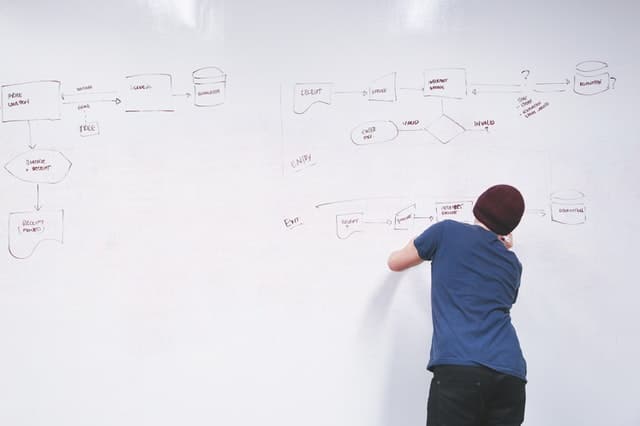Yeah the title sucks. That is what I get for having kids and living with teenagers – the constant meme-driven noise that pervades every aspect of home life.
The title is a deviation from an older meme about weightlifting that has been co-opted into a simple question about doing things that seem obvious and common. Things that we should all be doing.
Which brings us to the topic at hand.
Processes.
The thought of building and following a process can unfortunately have some negative connotations. Processes almost always carry overhead and paperwork. They take time. They can be tedious.
Yet there are processes all around us in the business world. They are, at a deep level, a means of communication. Of structure. Of collaboration.
To an Engineer, a finely tuned process is a thing of beauty.
But I digress. While the goal is to argue for processes and the value they bring, first a definition of what is and isn’t a process is needed.
So What is this Process thing anyways?
Looking up a definition for process, many results come back. It would be easy to slap a definition on the term and simply move on here. The problem here is that to truly define a good process, it needs a lot of rails around it. It needs a strong and narrow definition. It needs structure.
So let’s move forward – and by that let’s start with the origin of the word:
The origin of process is “from Latin prōcessus ‘a going forward,’ “
from Dictionary.com
So the start of the definition is that we are moving forward. That is a decent start, but we need a lot more than that.
A solid process must have the following:

A process is not a habit
Look – I get it. It does feel like by the wording, getting up every morning, brushing your teeth, taking a quick shower, putting on clothes, then chugging cup after cup of coffee to wake up is a process.
But is it really?
That is really a habit. It is something that is part of a routine. Or, in other words:
A habit is an action repeated regularly as part of a routine and is most likely performed in a subconscious or unintentional manner
Mark Canes – from: The Importance of Evaluating Processes during the Inventory Management Software Search

A process is more than one person
The morning routine described above is all about one single person. That is great for a routine or a habit.
However, it doesn’t work for a process. A process is a collective agreement defining steps and a desired outcomes. The word ‘collective’ gives it away. It means multiple people doing multiple things for one or many solutions.
In short, a process is something we all work together to achieve.
A process has a considered and planned outcome that should be measurable
We don’t do processes for our health. We do processes because they are considered, thought-out steps to achieved desired outcomes.
This doesn’t mean that those outcomes are always there and present from day 1!
If the desired solution of a process is to deliver every package correctly to a customer and to also measure and reduce the number of processing hours on average per package, then this process must include ways to measure and evaluate the process.
It also means that the first desired outcome, delivering every package correctly to a customer, can be evaluated from the first time the process is run. It is a binary endpoint. Either we did deliver it correctly or we didn’t. Each endpoint here is trackable against a goal of 100% delivery to target customers.

However, the other desired solution, to measure and reduce the number of hours on average per package, requires measurement and a baseline. It should also define what is ‘good enough’. This target may be something that can’t even be defined yet because the data isn’t there.
You can’t improve something that you can’t measure.
This part of the process will change over time. It will go through a period of metric capture and analysis. It will then need to change and modify the process to try and move the needle on the metric in the desired direction. Once the ideal average has been hit, then process should then move into a continuing mode where the average and variances against that average are still measured and evaluated to know that the process is still working correctly.
A process must be able to carry on once the originator has moved on
This is one of the big differences between a process and a habit.
What happens if the process originator moves on? What happens if they get hit by a bus or fired?
If the process grinds to a halt and isn’t used anymore then it wasn’t much of a process in the first place.
The creation of a process, whether by one or multiple people, is a challenge. However, it is a bigger challenge to implement a new process across multiple people or groups, get buy-in on that process, and then to have the patience to let the process establish while tweaking it for optimization.
This is essential and critical for the definition of a solid process.
It should also be noted here that this may not be a planned evolution!
How many times have you or someone that you know spent their first days in a new role learning the process from an incumbent in that role?
This is nothing more than them teaching you their process.

It doesn’t matter where that process came from. It might not be an actual process by the definitions stated here. It could be the collected habits form an individual. But when it transfers to another person, it definitely becomes a process even if it wasn’t one before.
It has outlived its creator.
Now, the jury may still be out on whether it is a solid and efficient process. Sometimes it is hard to discern whether a verbally transferred process is an intentional one or simply a recounting of the built-up habits from one or multiple individuals.
Yet, anything that transfers has outlived it’s creator and can follow steps to become a documented and efficient process.
A Process must have an owner and a trigger for each step
A good process doesn’t eliminate the need for humans to think and make decisions.
Instead, it defines ownership. It defines each step. It identifies triggering events for transitioning between steps.
These elements are crucial for a smoother process flow.
You could equate a process to a computer. Computers don’t think for themselves. They take inputs into a pre-defined system, do something with those inputs, then hand off the inputs to another part of the system.
Computers are simply collections of processes.
But what happens when the next step of the process isn’t defined? What happens when we get to the end of a step without a clear definition of where (and who) to go to next?
We aren’t talking about computer code here. Gaps in computer programs lead to errors, system hangups, and even dreaded blue screens of death showing on the monitor.
In this way, processes aren’t like computers. Processes are human-driven functions and come with human qualities and failure points.
To avoid these roadblocks, processes must have a defined owner and a trigger for each defined step.
The step owner is the person or groups responsible for accomplishing all tasks defined for that step. They must get things right and reach the trigger point.
The step trigger defines what status or state must be reached to hand things off to the owner of the next step.
Without these things, packages in the shipping process end up in a dark, dusty corner of the shipping warehouse and customers get angry.
How to Create A Process – Step 1 – Definition of Current System
One of the first things to consider when trying to build a process is to step back and simply document the habits, routines, and processes that are currently being used.
Don’t worry about labels right now. Simply focus on the “what”, “where”, and “who” for how the solution is currently achieved.
This is pretty easy.

If the goal is to create a solid process around shipping an order to a customer then start at the beginning.
- Where is the order entered into the system.
- What information is entered?
- Who enters that information?
Then follow the steps.
- What happens next?
- When does the next thing happen?
- Where does the information go?
- Who has ownership over each step?
Simply walk through each step answering these questions and hopefully you will end up back at a shipping dock watching a package being carted away by a delivery driver on its way to a customer.
However, you might find yourself at a dead end with a package in the back corner of a storage warehouse and not back on that loading dock. That is ok. Remember – the goal here is to create a defined and successful process. If the order entry and shipping process was working well then this exercise wouldn’t be needed, right?
So the current system should be at least somewhat understood at this point. It may be a loose definition. It may have huge gaps. Edge cases may be ignored. It may have big black holes where things can get lost and never seen again.
All of this is ok. Remember – this is why we are building a process!
It is best at this point to generate some documentation around the current system. People always have an easier time with understanding and acceptance with a starting point.
How to Create A Process – Step 2 – Define The Why
This is a crucial step in building processes. In Step 1 we defined the “what”, “where”, and “who”.

Now it is time to answer the question of “why” a process is needed here.
Why do we need to improve things around this system? What is the considered and planned outcome? What can we measure to evaluate and know that the process is on track and working?
All of these things go into the calculus of process creation.
There is one quick and easy answer to all of this.
We make processes to improve workflow, make things easier and more consistent, and to provide the people with the information needed to do their jobs each and every day.
So when creating a process, step back and try and define the “why”.
You can start by stepping back and looking at the process and answering these questions:
- What is the ideal desired outcome at the end of the process?
- What steps must be defined for a perfect workflow through this system?
- Who will own each step in a perfect workflow?
- What will trigger movement from each step to the next in a perfect workflow?
Once you have answers on the above, the easy part is done.
Now comes the hard part.
This is where the majority of flaws show up in processes. This is also something that it is nearly impossible to get right on the first try.
How to Create A Process – Step 3 – Documentation
This is the action stage for process management.
This starts by taking all of the information gathered to this point and putting it all down on paper.

It doesn’t really have to be on physical paper. But it does need to be documented somewhere. In Visio. On a flowchart. In a PDF. On a big printed poster for the breakroom. This documentation needs to be open, transparent, and available to anyone who wants to see it.
Processes can’t thrive in the dark. Processes also won’t survive if they are only recounted by word of mouth.
There are many reasons why documenting processes is a good idea.
Documentation provides a consistent way to get everyone on the same page. It is essentially a roadmap from how to get from point A to success at point B. It goes deeper than a roadmap in that it also seeks to define what to do if there is construction or an unexpected roadblock during any step of the journey.
Documentation also allows definition of black holes and edge cases.
Black holes are places where the process can drop off and things can fall into an abyss never to be seen again. It should be obvious that everyone wants to avoid black holes – but defining them in the methodology makes it easier for everyone to practice avoidance.
Edge cases are not as bad as black holes, but what happens if someone turns left instead of turning right at a critical step? Or, following the shipping example, what happens if there is a tape shortage? Edge cases are typically not common. Some may even be extreme outliers that probably will never happen.
But what happens if they do?
Most processes will ground to a halt.
It should also be recognized that it will never be possible to identify and document all possible black holes and edge cases. That is why the process needs to be continually reviewed and refreshed as new instances of these scenarios are found and identified.
The final comment on documentation is that it must be publicly available for everyone using the process to achieve the best results.
Providing people with a clear path and the context of why puts everyone that touches the process the same information and gets everyone on the same page.
How to Create A Process – Step 4 – Implementation
This can be the hardest step to achieve. A process only works as well as the people using it make it work.
Also, human beings carry a tremendous amount of inertia. Once moving in one direction it can be a monumental task to get them to change directions.
However, there are some elements to the new process that can help this transition.
First – the thinking has already been done for everyone. If the process is well documented then all people need to do is to read the process and understand that at that point in time then I need to do that thing. A person not having to think or make decisions always makes adoption of a new behavior easier.

Remember – the process is not trying to eliminate thinking. The best automotive plants have workers who follow processes all day every day, yet they all have the power to hit the big red button and stop the line. They follow their process but are ultimately responsible for the whole output. Seeing and understanding an issue either in this step of the process or an issue from another step of the process is critical to the overall success of what we are trying to achieve here.
One person will own this step in the process, but we all own the overall process and the (hopefully successful) results that come out of it.
Second – the why has been answered. Nobody likes to be yelled at when a customer order doesn’t ship or if it does ship but goes to the wrong address. Even if saving money through a more efficient process isn’t at the top of the list of benefits for a single person in the organization, avoiding screw-ups is always a good thing for everyone.
Like it or not, in the workplace we all like to avoid the blame game. If we can point out that we did our part and then handed it off to where someone else screwed things up it makes our lives easier. It is also unfortunately a human trait to want to watch a train wreck while hoping that we aren’t a part of said wreck.
This is where the success of the business and overall process can be tested. The best organizations and processes recognize that individual steps in a process need owners who assume the responsibility of getting that step completed in a timely manner. However, this ownership is not used as a cudgel to beat people up when things go wrong.
Quality processes have clear steps and lots of big red buttons that anyone can push to get attention to issues in the flow and also are built in a way that the success of the process is embraced by every person on the team and in the organization.
Step 5 – Rinse And Repeat
That is right. In the future all of these steps need to be done again. Probably on an ongoing basis.
Processes are not static things. They are living, breathing, and changing systems.
What happens if a new person comes in or out? What happens if someone identifies a way to make the whole process more efficient? What happens if business needs change?
What if?
A solid process recognizes that changes are a “when” not an “if” scenario.
Therefore, when things change, can the process change with it?
It is very easy to change a process. Simply go back and re-do all of the steps above.

The first time is the hardest. It assumes that there is nothing more than verbal stories to carry on processes.
The second time is easier. Now actual documentation and logic should be present to work from.
The review and rework iterations for a process should get faster over time. The critical element here is to not lose focus on the key elements of definition, identifying the “why”, documentation, and implementation.
Hopefully this information helps in defining your own processes for the world and business that you live and work in. Processes may seem tedious to some, but a well defined and optimized and efficient process flow can be a thing of beauty. I hope that you can surround yourself with beautiful processes wherever you are!
Thanks for reading!




Comments are closed, but trackbacks and pingbacks are open.